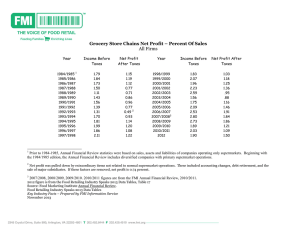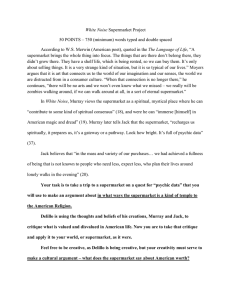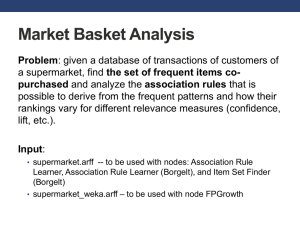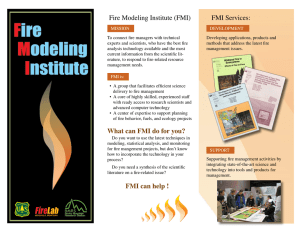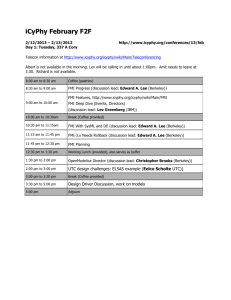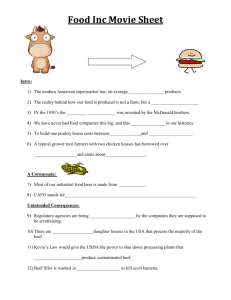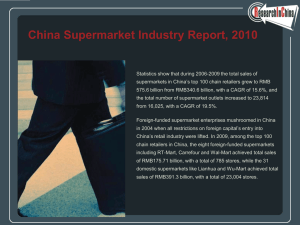Current Trends in Agriculture
advertisement
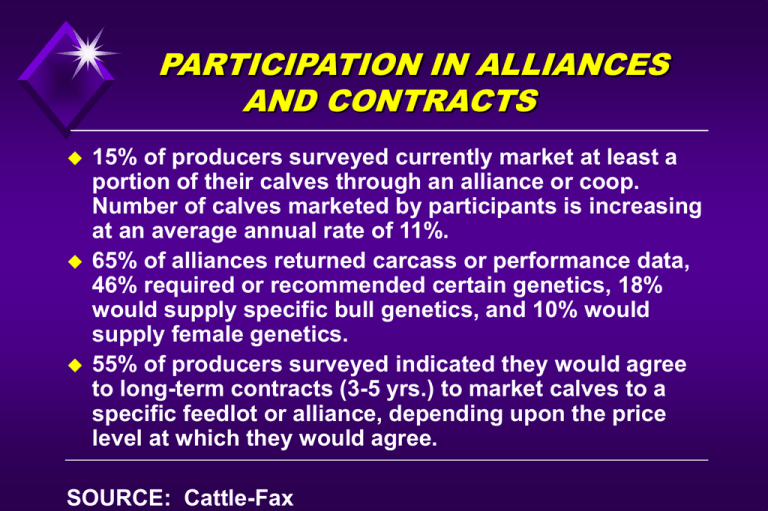
PARTICIPATION IN ALLIANCES AND CONTRACTS 15% of producers surveyed currently market at least a portion of their calves through an alliance or coop. Number of calves marketed by participants is increasing at an average annual rate of 11%. 65% of alliances returned carcass or performance data, 46% required or recommended certain genetics, 18% would supply specific bull genetics, and 10% would supply female genetics. 55% of producers surveyed indicated they would agree to long-term contracts (3-5 yrs.) to market calves to a specific feedlot or alliance, depending upon the price level at which they would agree. SOURCE: Cattle-Fax KEYS TO SUCCESS IN THE SEEDSTOCK BUSINESS 1. 2. 3. 4. 5. Find the money to get started and survive during the first difficult years. Know where your expertise lies and then put it to use. Seek out and listen to the most successful people in the business and never stop learning. As you grow, hire the best people available. The cattle business has only three significant assets—cattle, people and land. Get out of the way of your ego! Listen to your customers, your partners, and your employees. Also, study your competitors. SOURCE: Seedstock Digest (anonymous producer). SUPERMARKET TRENDS A study by FMI revealed the following: Fast-food chains have given back to supermarkets some of the market share gains they won in recent years. Percent of consumers eating fast food once or more a week has fallen from 38 to 32%. Take-out and home delivery meals have also declined. When consumers select a supermarket, their priorities are: 1) cleanliness; 2) produce quality; 3-tie) meat quality and price. SOURCE: Food Marketing Institute. MAJOR FORCES DRIVING THE PROGRESSION TO CASE-READY PRODUCTS 1st – Labor savings. 2nd – Out-of-stock and shrink in the meat case. 3rd – Convenience and consumer satisfaction. 4th – Food safety. SOURCE: Dan Murphy, Meat Marketing and Technology LARGEST GROCERY RETAILERS IN THE U.S. Percent of total supermarket sales: Top 3 control 31.2% of sales. Top 5 control 42.1% of sales. Top 10 control 62.0% of sales. Top 20 control 76.3% of sales. SOURCE: FMI (2001 sales). TOP TEN GROCERY RETAILERS IN U.S. Company No. stores Sales (billion $) % Market share Kroger Albertson’s Safeway Ahold USA Wal-Mart Supercenters TOTAL TOP 5 Sam’s Club Costco Delhaize America Publix Winn-Dixie TOTAL TOP 10 3,211 2,573 1,762 1,446 1,060 10,052 498 363 1,406 675 1,150 14,204 $ 50.7 $ 38.3 $ 34.3 $ 34.3 $ 20.1 $166.6 $ 18.4 $ 17.7 $ 15.2 $ 14.7 $ 12.9 $245.5 12.8% 9.7% 8.7% 8.7% 5.1% 42.1% 4.6% 4.5% 3.8% 3.7% 3.3% 62.0% SOURCE: FMI (2001 sales). DEVELOPMENT OF ANIMAL WELFARE STANDARDS The nation’s two largest supermarket companies, Kroger and Albertson’s, have announced their support of standards being developed by FMI (Food Marketing Institute) and NCCR (National Council of Chain Restaurants). The FMI-NCCR standards are not mandatory but are “expected” of their supermarket and restaurant members, respectively. To date, the following restaurant companies have developed separate animal husbandry/welfare standards to be required of their suppliers: -McDonald’s -Burger King -Wendy’s -Applebee’s SOURCE: Rod Smith, Feedstuffs, 7/8/02. NUTRIENT CONTENT OF LEAN BEEF A 3-oz. serving of lean beef contributes only 9% of the calories to an average 2000-calorie diet. Conversely, it supplies more than 10% of the recommended daily allowances for: -Protein……………………..................................... 50% -Zinc………………………………………………….. 39% -Vitamin B12…………………………………………. 37% -Selenium……………………………………….…... 24% -Phosphorus……………………………………….. 20% -Niacin……………………………………………….. 18% -Vitamin B6……………......................................… 16% -Iron…………………………………………...……… 14% -Riboflavin………………………………………....... 12% SOURCE: USDA and NCBA. AQUACULTURE IS GROWING AT A RAPID PACE Globally, fish is the most important single source of high-quality protein, providing 16% of the world’s animal protein consumption. And demand is increasing. Because growing numbers of fish species are being harvested into extinction, aquaculture will become one of the largest food-producing industries in the world within 10 years. Today farmed seafood makes up about a third of U.S. seafood consumption, and is increasing rapidly. Virtually all catfish and trout eaten around the world now come from farms, as do two-thirds of the shrimp. SOURCE: FAO U.S. IMPORTS OF GOODS (2001) Item $ Billions Food, feeds & beverages $ 46.7 Petroleum & products $103.8 Industrial supplies, except petroleum & products $167.2 Automotive vehicles, engines & parts $189.7 Consumer goods, except automotive $283.7 Capital goods, except automotive $298.8 *Computers, peripherals & parts $ 74.4 *Civilian aircraft, engines & parts $ 31.3 *Other capital goods $193.1 SOURCE: U.S. Dept. of Commerce. TOP TEN ANIMAL HEALTH COMPANIES (2001) Company Merial Pfizer Intervet Bayer Fort Dodge Schering-Plough Elanco Novartis Pharmacia Idexx SOURCE: Fountain Agricounsel. 2001 Sales (million $) 1,636 1,022 956 930 776 694 686 550 469 386
